The word as a basic unit of language
The word is the subject matter of Lexicology. The
word may be described as a basic unit of language. The definition of
the word is one of the most difficult problems in Linguistics because
any word has many different aspects. It is simultaneously a semantic,
grammatical and phonological unit.
Accordingly the word may be defined as
the basic unit of a given language resulting from the association of
a particular meaning with a particular group of sounds capable of a
particular grammatical employment. This
definition based on the definition of a word given by the eminent
French linguist Arthur Meillet does
not permit us to distinguish words from phrases. We
can accept the given definition adding that a word is the smallest
significant unit of a given language capable of functioning alone and
characterized by positional mobility within a sentence, morphological
uninterruptability and semantic integrity.
In Russian Linguistics it is the word but not the morpheme as in
American descriptive linguistics that is the basic unit of language
and the basic unit of lexical articulation of the flow of the speech.
Thus, the word is a structural and
semantic entity within the language system. The word is the basic
unit of the language system, the largest on the morphological level
and the smallest on the syntactic level of linguistic analysis.
As any language unit the word is a two facet unit possessing both its
outer form (sound form) and content (meaning) which is not created in
speech but used ready-maid. As the basic unit of language the word is
characterized by independence or separateness (отдельность),
as a free standing item, and identity (тождество).
The word as an independent
free standing language unit is
distinguished in speech due to its ability to take on grammatical
inflections (грамматическая
оформленнасть) which makes it
different from the morpheme.
The structural
integrity (цельная
оформленнасть) of the word
combined with the semantic integrity and morphological
uninterruptability (морфологическая
непрерывность) makes the word
different from word combinations.
The identity of the
word manifests itself in the ability of
a word to exist as a system and unity of all its forms (grammatical
forms creating its paradigm) and variants: lexical-semantic,
morphological, phonetic and graphic.
The system showing a word in all its word forms is
called its paradigm. The lexical meaning of a word is the same
throughout the paradigm, i.e. all the word forms of one and the same
word are lexical identical while the grammatical meaning varies from
one form to another (give-gave-given-giving-gives;
worker-workers-worker’s-workers’).
Besides the grammatical forms of the words (or
word forms), words possess lexical varieties called variants of words
(a word – a polisemantic word in one of its meanings in which it is
used in speech is described as a lexical-semantic variants. The term
was introduced by A.I. Smernitskiy; e.g. “to learn at school” –
“to learn about smth”; man – мужчина/человек).
Words may have phonetic, graphic and morphological variants:
often – [Þfən]/[
Þftən] – phonetic
variants
birdy/birdie –
graphic variants
phonetic/phonetical – morphological
variants
Thus, within the language system the word exists as a system and
unity of all its forms and variants. The term lexeme may
serve to express the idea of the word as a system of its forms and
variants.
Every word names a given referent and another one and this
relationship creates the basis for establishing understanding in
verbal intercourse (общение). But because
words mirror concepts through our perception of the world there’s
no singleness in word-thing correlations.
As reality becomes more complicated, it calls for
more sophisticated means of nomination. In recent times Lexicology
has developed a more psycho-linguistic and ethno-cultural orientation
aimed at looking into the actual reality of how lexical items work.
Соседние файлы в папке Lecture1
- #
- #
- #
- #
THE WORD AS THE UNIT OF MORPHOLOGY Lecture 3
LECTURE OUTLINE The complexity of the phenomenon. Different approaches taken. The specific features of the word as the unit of language. The word and the word form.
THE WORD IS THE CENTRAL UNIT OF LANGUAGE, ISN’T IT? The Bible: ‘In the beginning was the Word’; God gave Adam the power to name all things. Any mother of a child started talking: “Tommy (or Sally) has said his (her) first word! Words name things, sentences communicate ideas. The word is difficult to define, ambiguity discourages linguists.
DEFINING THE WORD A word is characterized by different, often contradictory traits depending on theoretical background and descriptive context; different perspectives – different definition.
DEFINING THE WORD (a) phonetic-phonological level: words are the smallest segments of sound that can be theoretically isolated by word accent and boundary markers like pauses, clicks, and the like, and which are further isolated on a (b) orthographic-graphemic level by blank spaces in writing or print;
DEFINING THE WORD (c) on the morphological level, words are characterized as the basic elements of grammatical paradigms and are distinguished from the morphologically characterized word forms, cf. write vs writes, wrote, written; they are structurally stable and cannot be divided, and can be described as well by specific rules of word formation;
DEFINING THE WORD (d) on the lexical-semantic level, words are the smallest, relatively independent carriers of meaning that are codified in the lexicon; (e) words can be described syntactically as the smallest permutable and substitutable units of a sentence.
THREE MAIN DIRECTIONS The word as a semantic unit, the unit of meaning. The word is a marked phonological unit. The words as an indivisible unit.
DEFINING THE WORD SEMANTIC APPROACH The word is a unit of a particular meaning with a particular complex of sounds capable of a particular grammatical employment. Criminal and lawyer vs. criminal lawyer; Foot (part of a leg, part of the mountain); Running in the morning is great vs. I go for a run every morning.
DEFINING THE WORD PHONOLOGICAL CRITERION Compare: that stuff that’s tough a nice cake an ice cake grey day Grade A On hearing these words (without proper context) the meaning cannot be distinguished.
DEFINING THE WORD AS AN INDIVISIBLE UNIT Bloomfield a ‘minimum free form’, that can occur in isolation. a, the do not occur in isolation!
PROVIDING THE LISTS OF FEATURES The word possesses: uninterruptebility (a chatterbox vs. a new blue box); looseness in reference to the place in a sequence (Away he went vs. he went away); a bilateral entity (content side and expression side).
PROVIDING THE LISTS OF FEATURES the minimal unit of language which possesses relevant positional independence); the smallest unit which can fulfills certain syntactic functions; the biggest unit of morphology.
PROVIDING THE LISTS OF FEATURES a meaningful unit differentiating word-groups at the upper level and integrating morphemes at the lower level; the main expressive unit of language, which ensure though-forming function of language; the basic nominative unit of language (the naming function of language is realized); a level unit, which belongs to the upper stage of the morphological level / to the lexemic level; a bilateral entity (content/ expression).
THE WORD VS. THE WORD FORM language vs. speech dichotomy The words of a language being used in speech are represented by a number of word forms. The word form is a linguistic unit which carries grammatical information identified through contrast with other forms of the same word. The whole set of grammatical forms of a word constitutes its paradigm. Write (writes, is writing, have written).
THE WORD FORM The concrete realization of the word as a lexical and grammatical unity in speech. The word form (contrasted with the word) is only characterized with the grammatical meaning, fixed (reflected) in specific formal markers. The grammatical meaning can be expressed in one graphic unit or by adding other units as well: synthetic (walked, gave it to me) and analytic (is walking, saw me).
Слайд 1The Word As The Basic Unit Of The Language
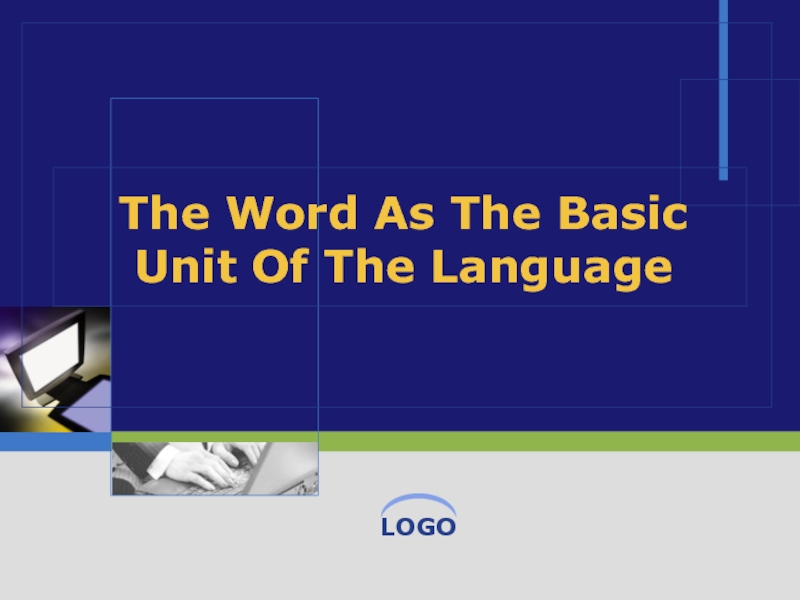
Слайд 2The word is a unit of speech that serves the
purposes of human communication.
The word can be perceived as
the total of the sounds which comprise it.
The word, viewed structurally, possesses several characteristics.
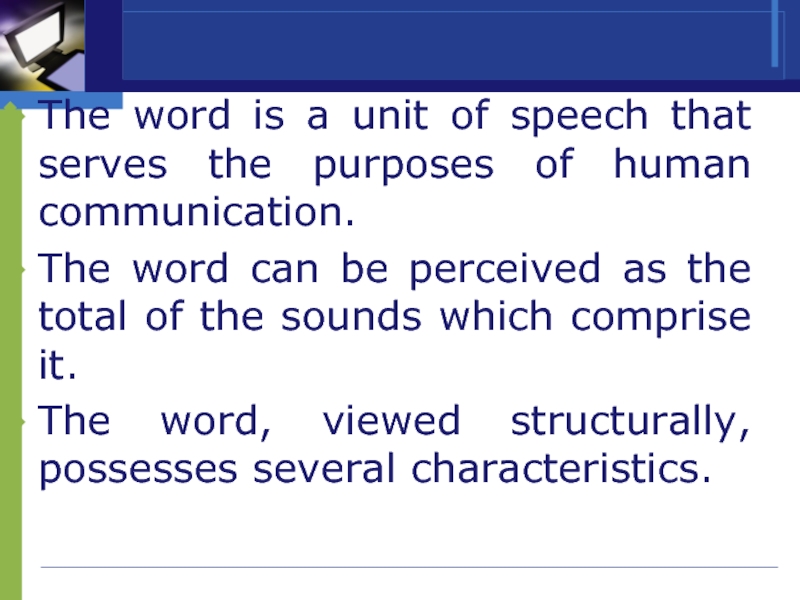
Слайд 3Word-meaning
Two schools:
the referential approach, which seeks to formulate the essence
of meaning by establishing the interdependence between words and the
things or concepts they denote
the functional approach, which studies the functions of a word in speech and is less concerned with what meaning is than with how it works
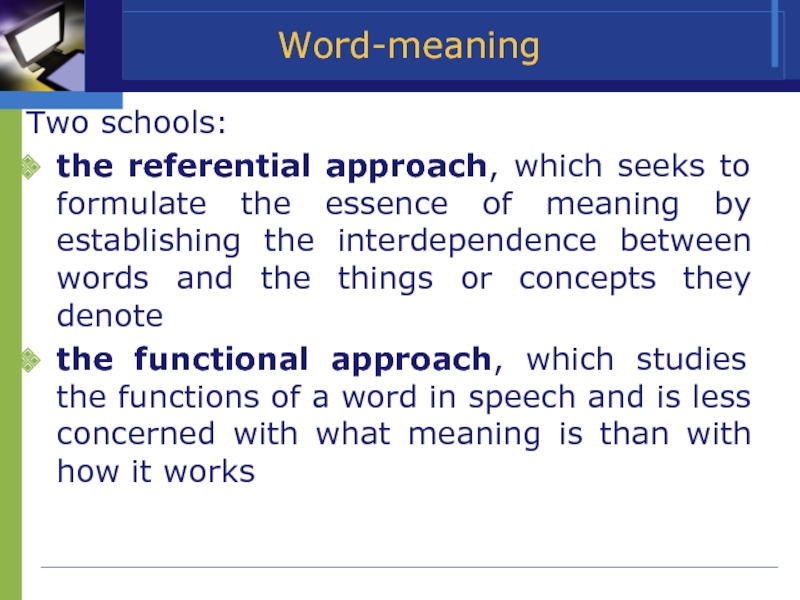
Слайд 5There is no inherent connection between this particular sound-cluster and
the meaning of the word.
English dove, Russian голубь
Seal – “a
piece of wax, lead”
Seal – “a sea animal”
O.E. lufian, Mn.E. love
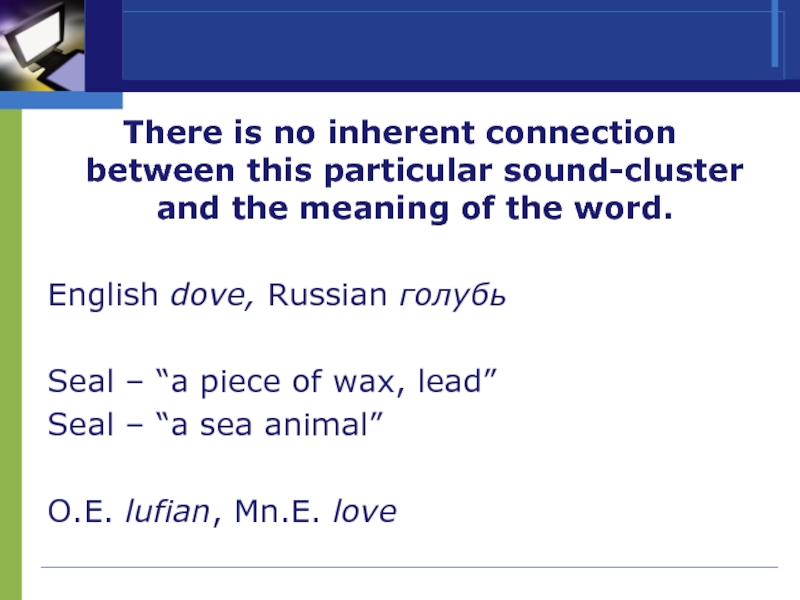
Слайд 6Concept is a category of human cognition. Concept is the
thought of the object that singles out its essential features.
Our concepts abstract and reflect the most common and typical features of the different objects and phenomena of the world. Being the result of abstraction and generalisation all concepts are almost the same for the whole of humanity in one and the same period of its historical development.
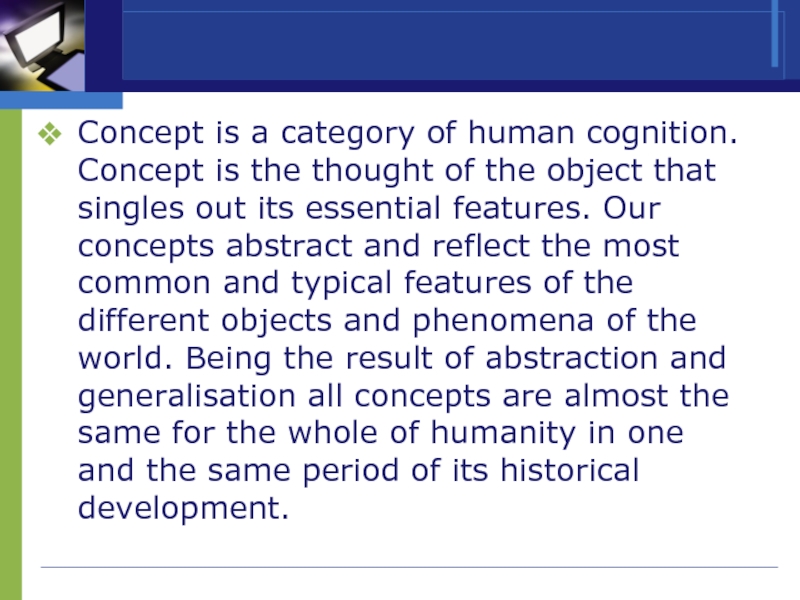
Слайд 9The structure of the word
External structure (morphological)
post-impressionists:
prefixes post-, im-
root
press
noun-forming suffixes -ion, -ist
grammatical suffix of plurality –s
Internal structure (semantic)
The
word’s meaning
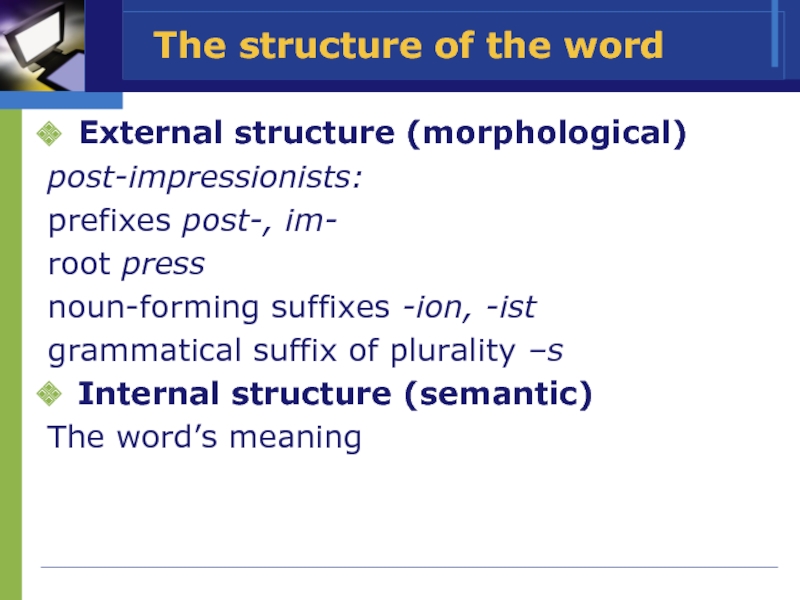
Слайд 11www.themegallery.com
Company Name
The Etymology of English Words
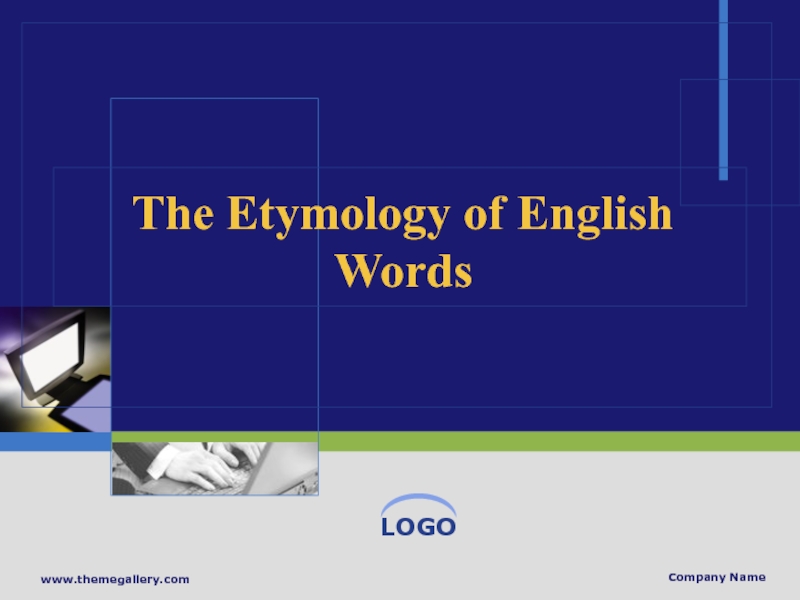
Слайд 12www.themegallery.com
Company Name
The first century В. С.
butter and cheese (Lat. butyrum,
caseus)
cherry (Lat. Cerasum)
pear (Lat. Pirum)
pepper (Lat. Piper)
plant (Lat. Planta)
cup
(Lat. cuppa)
kitchen (Lat. coquina)
port (Lat. portus)
wine (Lat. vinum)
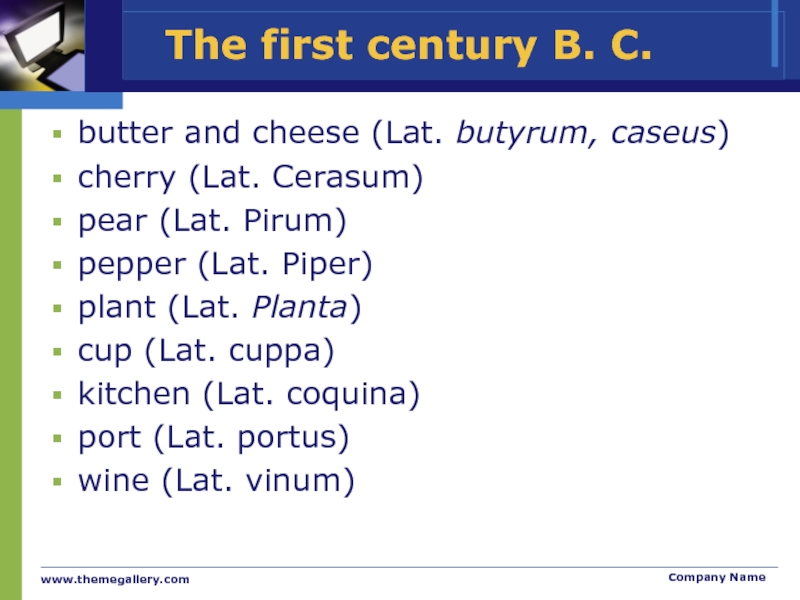
Слайд 13www.themegallery.com
Company Name
The fifth century A. D.
Mod. E. bald, down, glen,
druid, bard, cradle
Avon, Exe, Esk, Usk, Ux
Celtic Llyn
+ dun
Street (Lat. strata via)
Wall (Lat. Vallum)
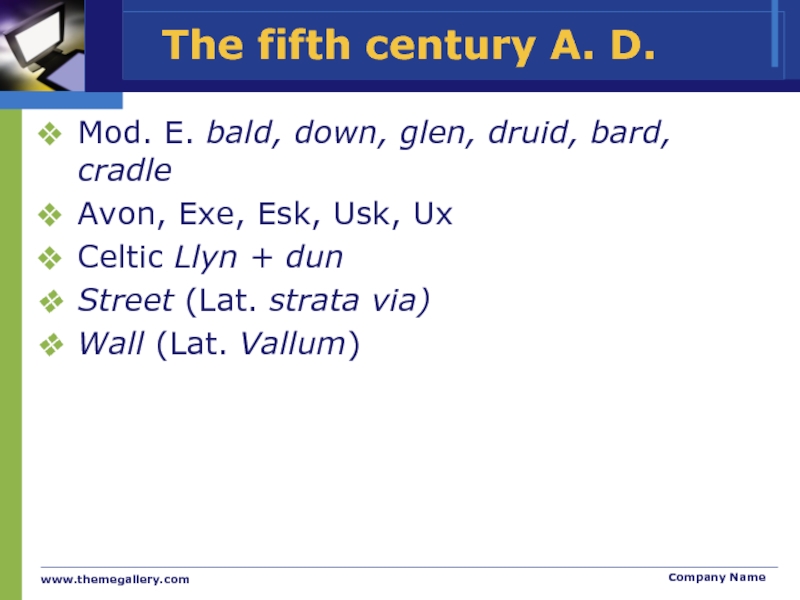
Слайд 14www.themegallery.com
Company Name
The seventh century A. D.
priest (Lat. presbyter)
bishop (Lat. Episcopus)
monk (Lat. monachus)
nun (Lat. nonna)
candle (Lat. candela)
school (Lat. schola, of
Greek origin)
magister (Lat. magister)
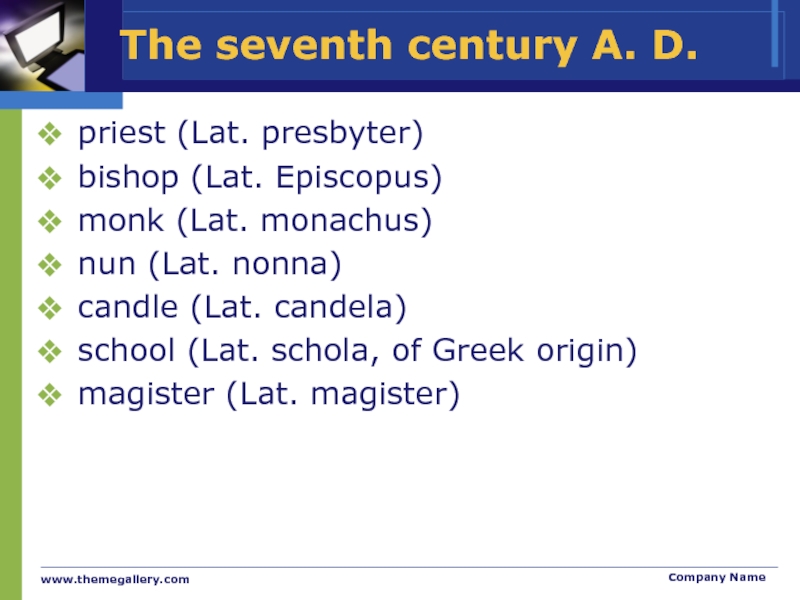
Слайд 15www.themegallery.com
Company Name
End of the 8th –middle of the 11th
Scandinavian
borrowings: call, take, cast, die, law
husband, (< Sc. hus +
bondi, i. e. «inhabitant of the house»), window (< Sc. vindauga, i. e. «the eye of the wind»)
ill, loose, low, weak
sky, skill, skin, ski, skirt
О. Е. dream (“joy”) – Scandinavian draumr (Germ. Traum «dream“, R. дрёма)
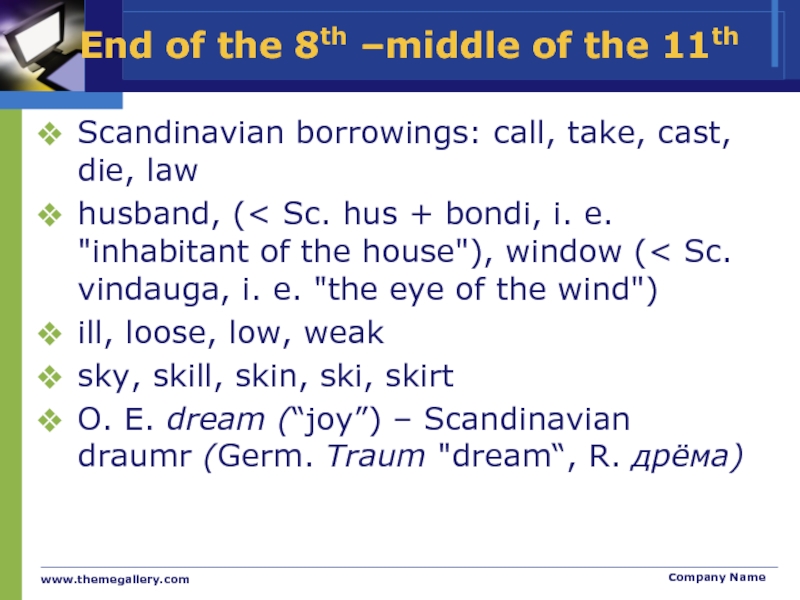
Слайд 16www.themegallery.com
Company Name
1066
Administrative words: state, government, parliament, council, power
Legal terms:
court, judge, justice, crime, prison
Military terms: army, war, soldier, officer,
battle, enemy
Educational terms: pupil, lesson, library, science, pen, pencil
table, plate, saucer, dinner, supper, river, autumn, uncle
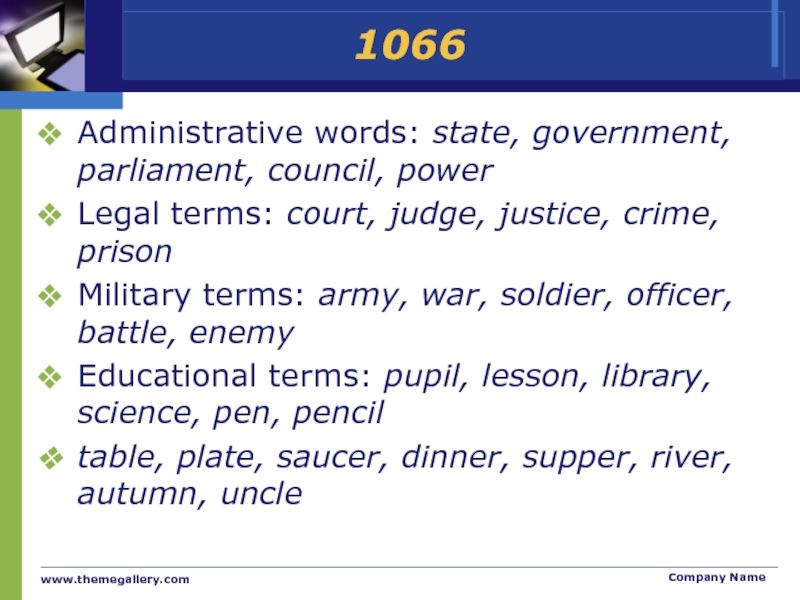
Слайд 17www.themegallery.com
Company Name
The Renaissance Period
abstract words (major, minor, intelligent, permanent,
to elect, to create)
scientific and artistic terms (status, phenomenon, philosophy,
method, music)
Greek Renaissance borrowings (atom, cycle, ethics, esthete)
Parisian borrowings (regime, routine, police, machine, ballet, scene, technique)
Italian (piano, violin, opera, alarm, colonel)
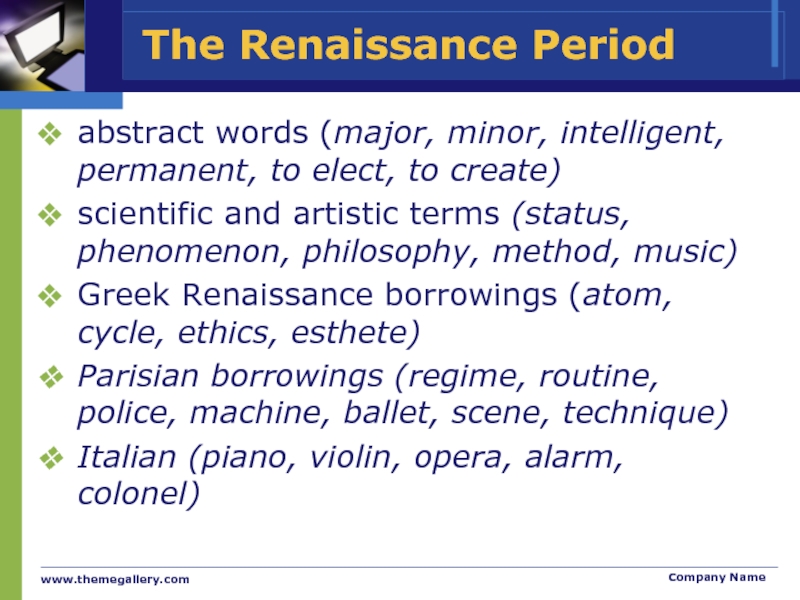
Слайд 18www.themegallery.com
Company Name
The Etymological Structure of English Vocabulary
The native element
Indo-European element
Germanic element
English Proper element (no earlier than 5th c. A.
D.)
The borrowed element
Celtic (5th — 6th c. A. D.)
Latin (1st group: 1st с. В. С. 2nd group: 7th c. A. D. 3rd group: the Renaissance period)
Scandinavian (8th — 11th c. A. D.)
French (1. Norman borrowings: 11th — 13th c. A. D. 2. Parisian borrowings (Renaissance))
Greek (Renaissance)
Italian, Spanish (Renaissance and later)
German, Indian, Russian and some other groups
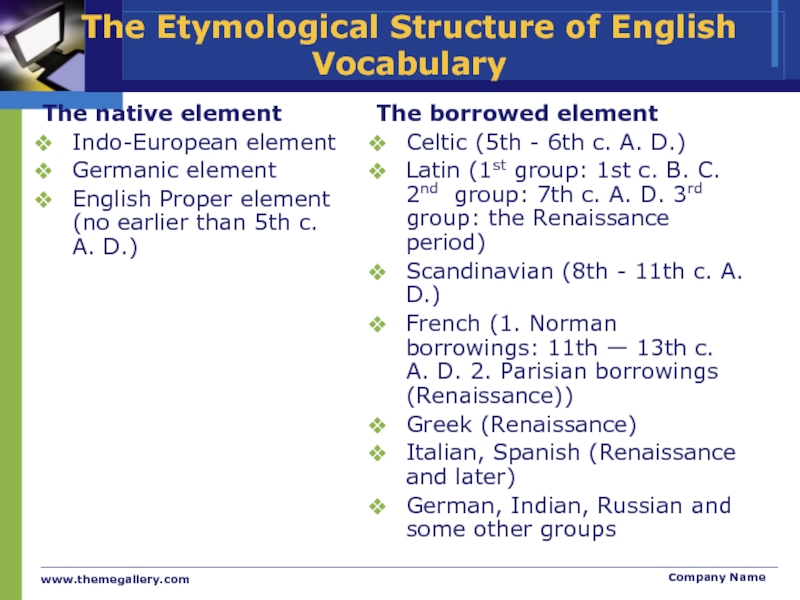
Слайд 19www.themegallery.com
Company Name
Indo-European element
Words of roots common to all or most
languages of the Indo-European group.
I. Family relations: father, mother,
brother, son, daughter.
II. Parts of the human body: foot, nose, lip, heart.
III. Animals: cow, swine, goose.
IV. Plants: tree, birch, corn
V. Time of day: day, night.
VI. Heavenly bodies: sun, moon, star.
VII. Numerous adjectives: red (cf. Ukr. рудий, R. рыжий), new, glad, sad.
VIII. The numerals from one to a hundred.
IX. Pronouns — personal (except they which is a Scandinavian borrowing); demonstrative.
X. Numerous verbs: be, stand, sit, eat, know.
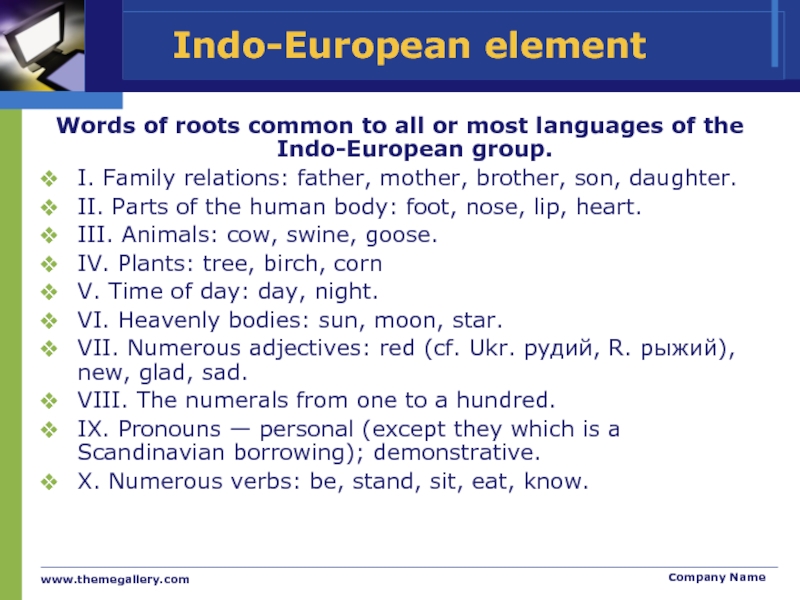
Слайд 20www.themegallery.com
Company Name
The Germanic element
Words of roots common to all or
most Germanic languages.
I. Parts of the human body: head,
hand, arm, finger, bone.
II. Animals: bear, fox, calf.
III.Plants: oak, fir, grass.
IV.Natural phenomena: rain, frost.
V. Seasons of the year: winter, spring, summer.
VI. Landscape features: sea, land.
VII. Human dwellings and furniture: house, room, bench.
VIII. Sea-going vessels: boat, ship.
IX. Adjectives: green, blue, grey, white, small, thick, high, old, good.
X. Verbs: see, hear, speak, tell, say, answer, make, give, drink.
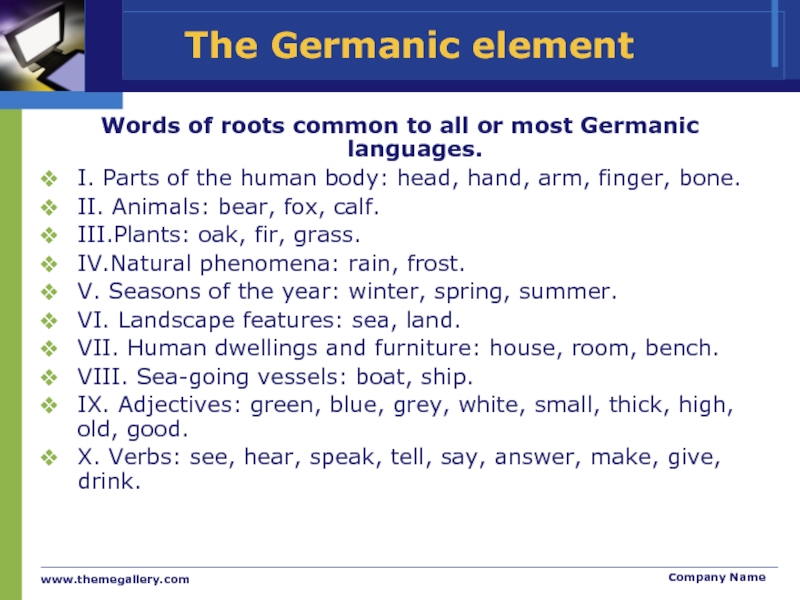
Слайд 21www.themegallery.com
Company Name
Star: Germ. Stern, Lat. Stella, Gr. aster.
Sad: Germ. satt,
Lat. satis, R. сыт, Snscr. sd-.
Stand: Germ. stehen, Lat. stare,
R. стоять, Snscr. stha-.
English proper words: bird, boy, girl, lord, lady, woman, daisy, always
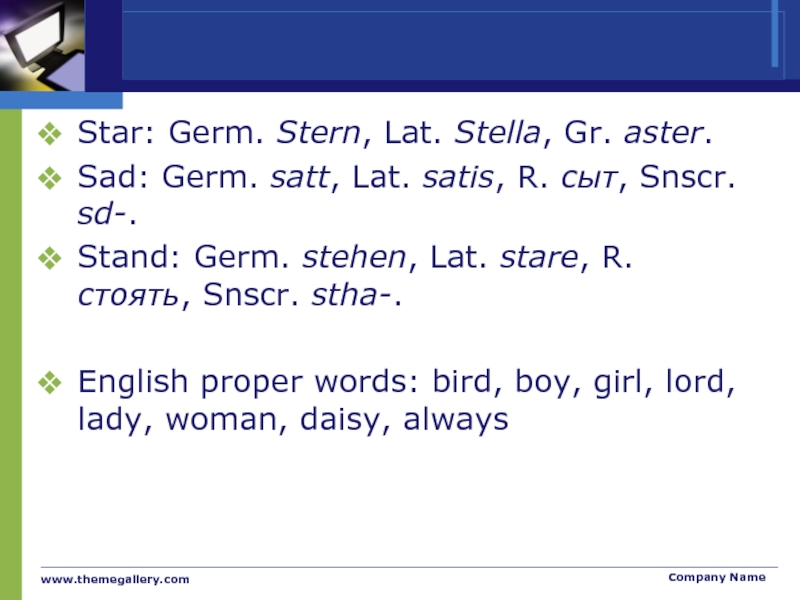
Слайд 22
4 main types of words can be
found in the English language:
Root words are words that have
only one root morpheme in their structure, e.g., boy, girl, pen, pencil, etc.
Derived words/ derivatives are words that have one root morpheme and one of several affixes in their structure, e.g. manhood, rewrite, unlike, etc.
Compound words are words that have 2 or more root morphemes in their structure starfish (+compound derivatives/ derivational compounds – built by composition in which one stem is derived, e.g., blue-eyed, old-timer, teenager, kind-hearted, etc.)
Shortenings/ contracted words are words formed by contracting certain elements of an existing word or word group, e.g., TV, exam, bus (omnibus), etc.
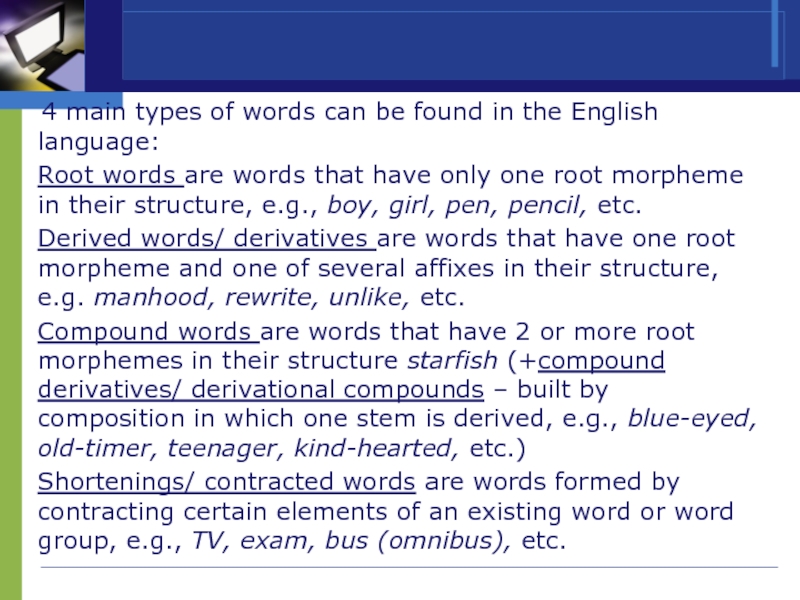
Слайд 23The most productive ways of word-building:
Conversion
e.g. water (n) -to water
(v); dry (adj) — to dry (v); must (v) —
a must (n), go (v) — a go (n).
Composition/ Compounding
Holiday(holy+day),breakthrough(break+through), bedroom (bed+room)
Derivation
The compound word ‘unkindness’ ‘kind’ is the base, un- the prefix and -ness the suffix; or in “disjoined’, “join’ is the base, dis- the prefix and -ed the suffix.
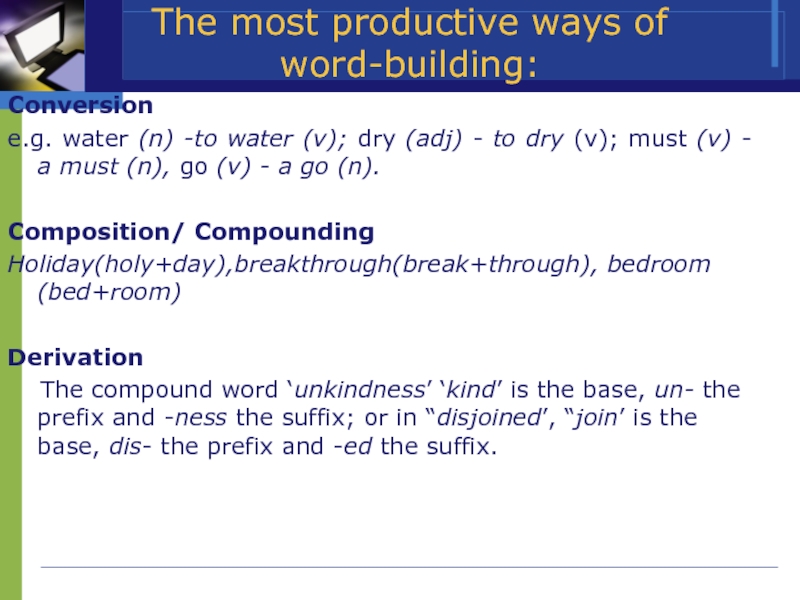
Слайд 24Homonyms
Homonyms proper (syn. absolute, perfect) – words identical in pronunciation
and spelling, e.g. temple – 1) висок, 2) храм; seal
– 1) печать, 2) тюлень; ball – 1) мяч, 2) бал, bark – 1) кора, 2) лай, etc.
Homophones – words identical in sound-form but different both in spelling and in meaning, e.g. to know – no, not – knot, to meet – meat, piece – peace, write – right, sea – see, son – sun, bye – buy – by, etc.
Homographs – words identical in spelling but different both in their sound-form and meaning, e.g. bow /bəʊ/ лук – /baʊ/ поклон, row /rəʊ/ ряд – /raʊ/ ссора, lead(v) /liːd/ вести – /lɛd/ свинец, tear (v) /tɛː/ рвать – /tɪə/ слеза, etc.
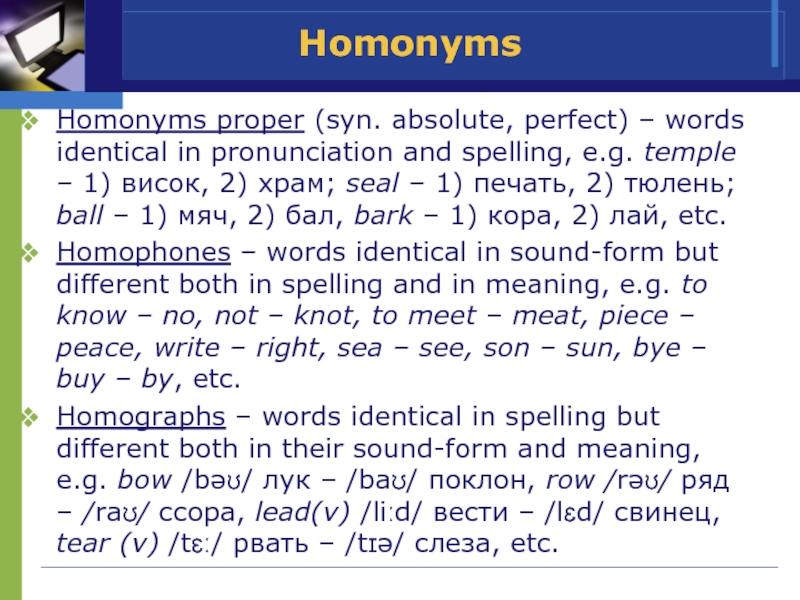
Слайд 25Semantic changes
Semantic change in the context of words describes the
gradual shift in the conventional meaning of words, as people
use them in new types of contexts and these usages become normal. The meaning of a word can change in the course of time. Transfer of the meaning is called lexico-semantic word-building. In such cases the outer aspect of a word does not change.
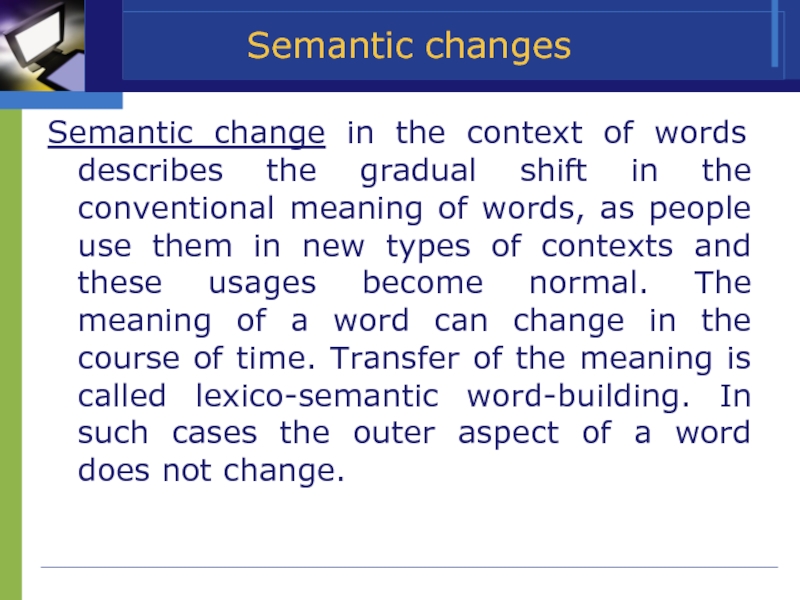
Слайд 26Types of semantic changes
Amelioration/əˌmiːlɪəˈreɪʃ(ə)n/ or elevation (a semantic shift of
meaning) e.g., pretty < OE: prættig ‘crafty, sly‘
Pejoration of
meaning (also degradation of meaning) e.g., spinster ‘unmarried woman’ < ‘one who spins’
Broadening (extension, generalization or widening) of meaning e.g., dog =>specific powerful breed of dog => all breeds or races of dog
Semantic narrowing of meaning (or specialization) e.g., wife => OE ‘woman’ =>’woman of humble rank or low employment’ => ‘married woman, spouse‘
Bleaching e.g., awfully, terribly, horribly (awfully late, awfully big, awfully small) or pretty (pretty good, pretty bad . . .)
Metaphor e.g., «The rain came down in long knitting needles.» (Enid Bagnold, National Velvet)
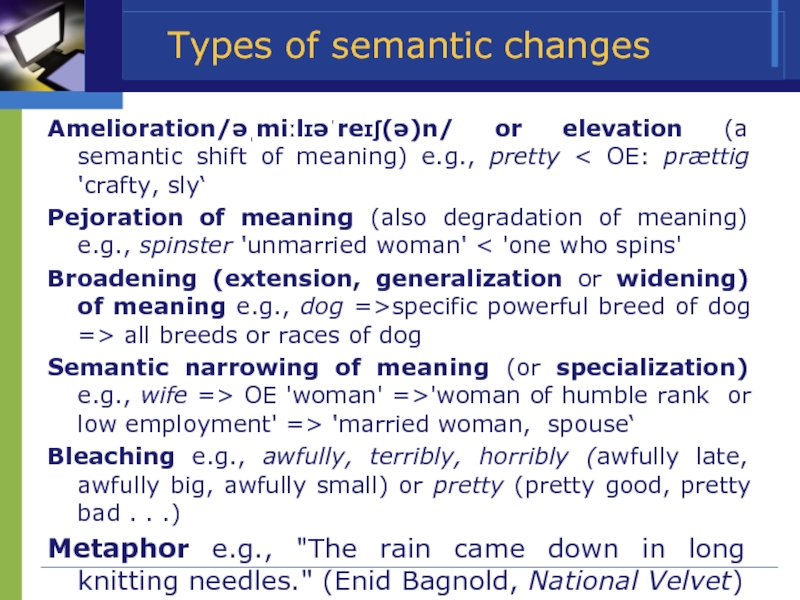
Слайд 27Types of semantic changes
Metonymy /mɪˈtɒnɪmi/ e.g., «Fear gives wings.» (Romanian
proverb)
Synecdoche / sɪˈnɛkdəki / e.g., hand ‘hired hand, employed
worker‘
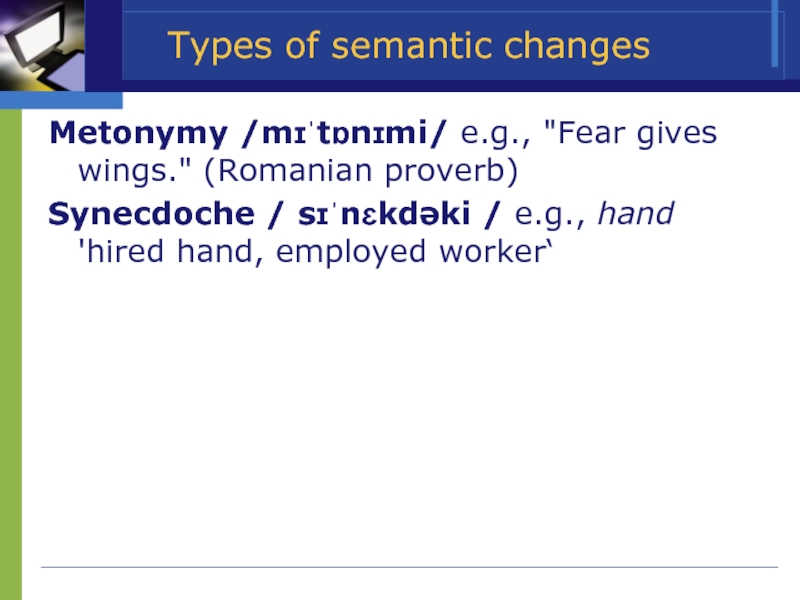
Слайд 28www.themegallery.com
Company Name
Exercises
Subdivide all the following words of native origin into:
a) Indo-european, b) Germanic, c) English proper.
Daughter, woman, room, land,
cow, moon, sea, red, spring, three, lady, always, goose, bear, fox, lord, tree, nose, daisy, heart
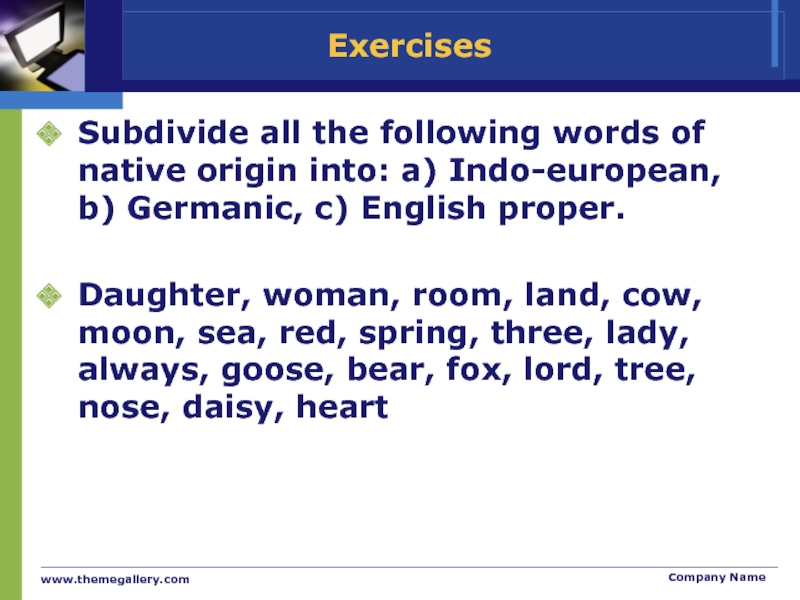
Слайд 29Exercises
Choose the correct answer.
A branch of lexicology which is devoted
to the study of meaning is called
a) Etymology
b) Dialectology
c) Semantics
d)
Phraseology
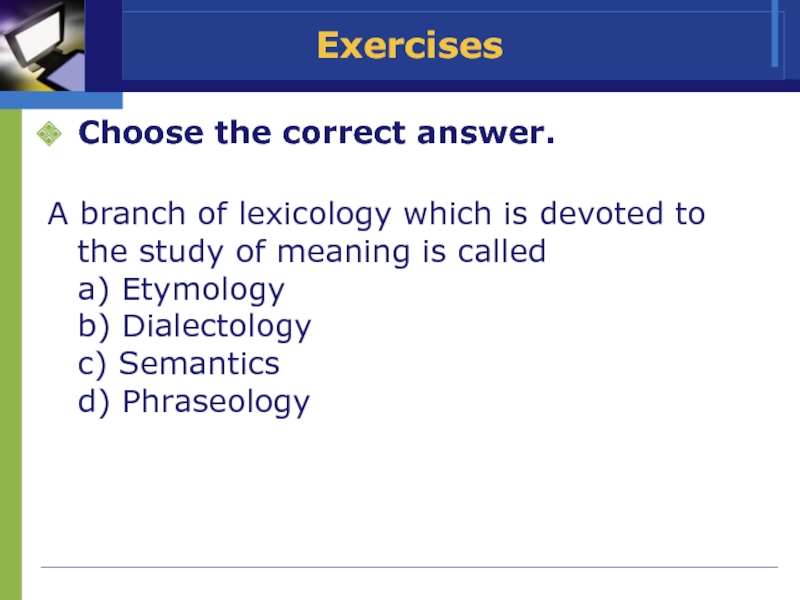
Слайд 30Exercises
Choose the correct answer.
The referential approach
a) seeks to formulate the
meaning by establishing the interdependence
between words and the things or
concepts they denote
b) studies the functions of a word in speech and is concerned with how
meaning works.
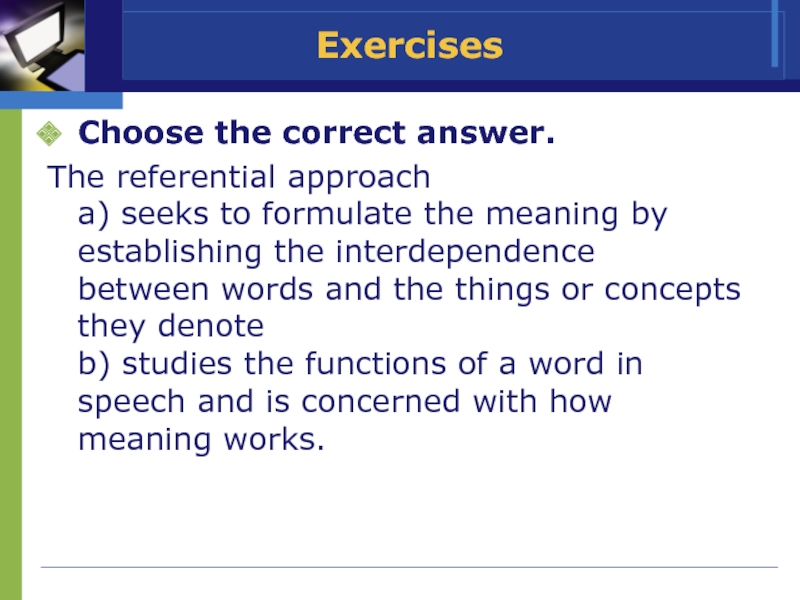
Слайд 31Choose the right answer.
1. She wants an apple, not a
___.
pear
pair
2. The bus ___ is one dollar.
fare
fair
3. ___ house is near the lake.
There
Their
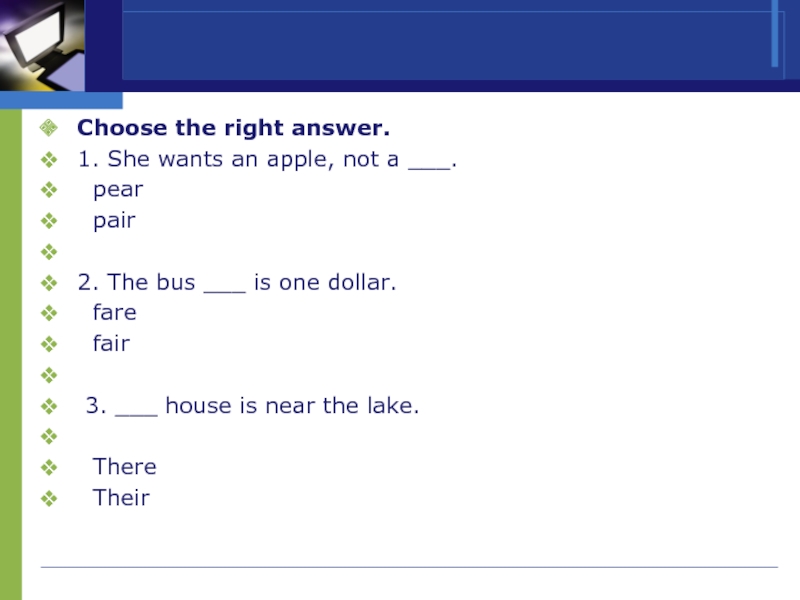
Слайд 324. No eating or drinking ___ on the sports ground!
aloud
allowed
5. The book teaches how to spell ___.
write
right
6. We took a ___ from work and went for a walk.
break
brake
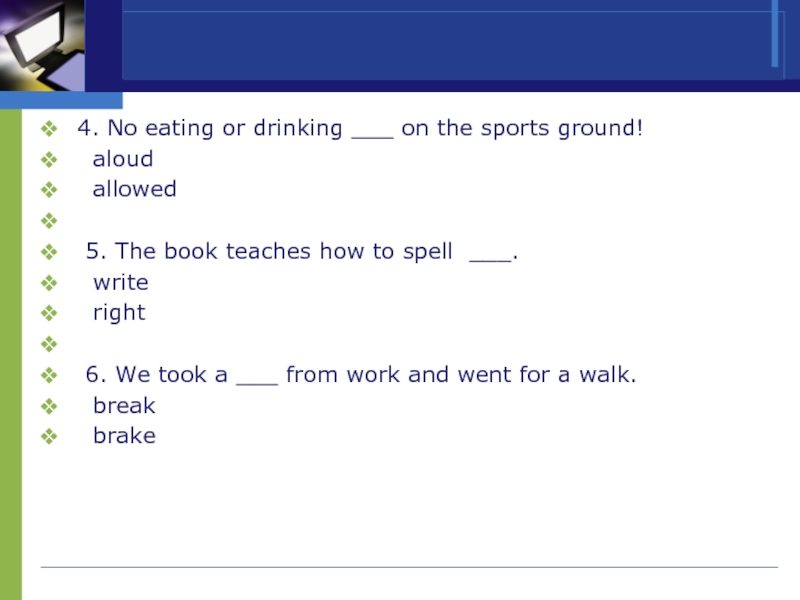
Слайд 33 7. We must consider this situation as a ___ .
hole
whole
8. It’s time to ___ the seeds.
sew
sow
9.
Mix some ___ with milk, eggs, and sugar and make cookies for the children.
flower
flour
10. It was more than I could ___ .
bare
bear
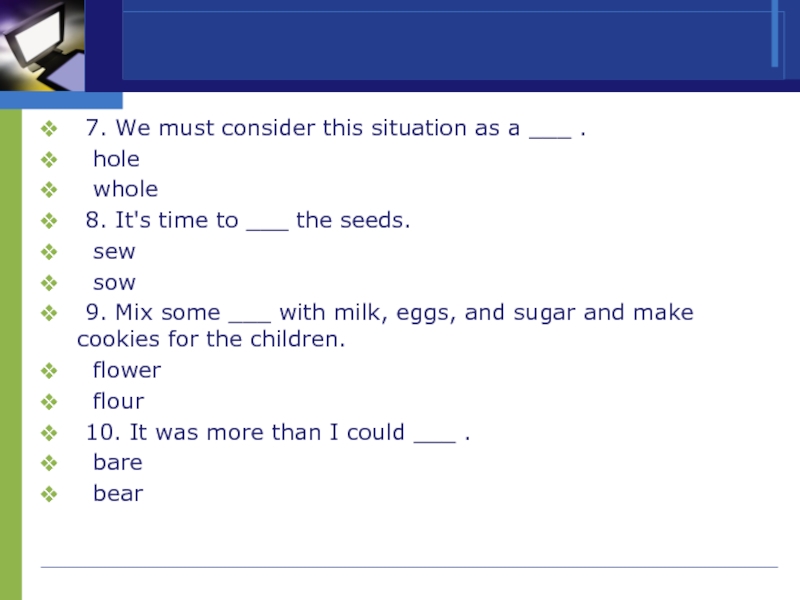
Слайд 34Semantic changes
1. Processes of Semantic Change
Identify the type of semantic
shift that has occurred in each case. Choose either Metaphor
or Metonymy.
a. barbecue ‘a rack for cooking meat over a fire’ > barbecue ‘a social event at which food is cooked over a fire’
b. influence ‘something which has flowed in’ > influence ‘something which affects someone without apparent effort’
c. mouth ‘the body opening through which an animal takes food’ > mouth ‘a person’ (eg. «three mouths to feed»)
d. solve ‘to loosen’ > solve ‘to clear up something puzzling’
e. counter ‘a device for counting’ > counter ‘a surface on which various devices can be placed’
f. mouth ‘the body opening through which an animal takes food’ > mouth ‘an opening into a cave or canyon’
g. white shirt ‘a shirt that is white in color’ > white shirt ‘a manager’
Слайд 35 2. Result of Semantic Change
For each example, tell whether
the result of the semantic shift is Narrowing, Degeneration, Widening,
or Amelioration.
a. OE wif ‘a woman’ > Modern English wife ‘a married woman’
b. nuke ‘to destroy with nuclear weapons’ > nuke ‘to destroy in any manner’
(eg. Buffy nuked her Porsche last night.)
c. ME marshall ‘groom for horses (literally ‘horse slave’)’ > Modern English marshall ‘high ranking officer’
d.OE steorfan ‘to die (of any cause)’ > Modern English starve ‘to die from hunger’
e. Middle English vilein ‘feudal serf, farmer’ > Modern English villain ‘a wicked or evil person’
f. OE bouchier ‘one who slaughters goats’ > Modern English butcher ‘one who slaughters animals’
g. Middle English girle ‘child’ > Modern English girl ‘female child’
h. lyric ‘poem to be sun with a lyre’ > lyric ‘any poem to be sung’
i. lewd ‘of the laity (i.e. non-church)’ > lewd ‘indecent’
j. OE mete ‘any food’ > Modern English meat ‘animal flesh’
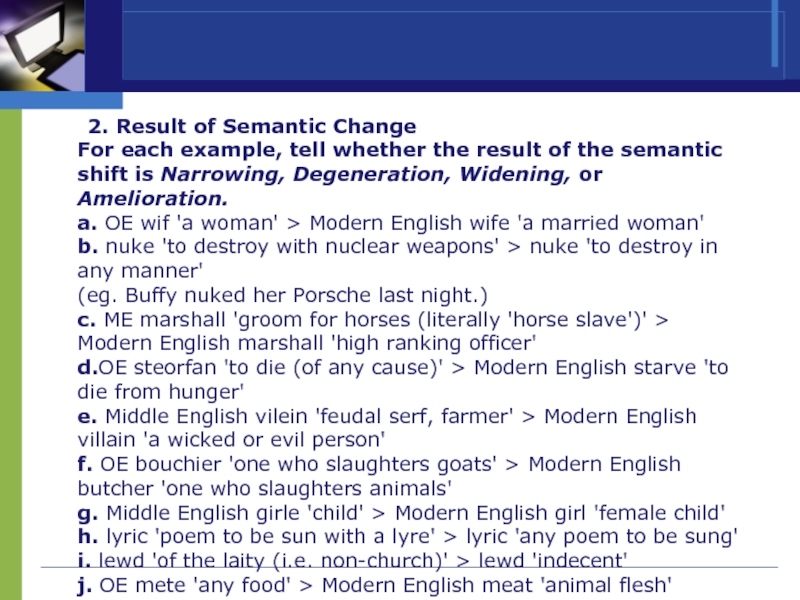
Скачать материал

Скачать материал






- Сейчас обучается 268 человек из 64 регионов


Описание презентации по отдельным слайдам:
-
1 слайд
Word as the basic unit of language
Lecture 2. -
2 слайд
§ 1. The Definition of the Word
A successful definition should 1) contain essential features of a word and 2) draw a sharp borderline between various linguistic units:
1.1. word and phoneme (Oh! I)
1.2. word and morpheme (man, wise, ism)
1.3. word and phrase (all right, alarm clock, the reciprocal pronouns each other and one another) -
3 слайд
1.1. Unity of form and meaning
Word — Formphonetic/graphic morphological structure grammar form
Essential features
Word – Meaningdenotational connotational lexico-grammatic grammatic
-
4 слайд
1.2. When used in sentences words are syntactically organized. Their freedom of entering into syntactic constructions is limited by rules and constraints
They told me this story vs. They spoke me this story
to deny smth categorically vs. to admit categorically1.3. Words are characterized by (in)ability to occur in different situations
In a business letter: ‘I was a bit put out to hear that you are not going to place the order with us’
To a friend: ‘I regret to inform you that our meeting will have to be postponed. -
5 слайд
Distinctive features: Within the scope of linguistics the word has been defined syntactically, semantically, phonologically and by combining various approaches.
Syntactic: H. Sweet «the minimum sentence“
L. Bloomfield «a minimum free form».
Syntactic and semantic aspects:
E. Sapir — «one of the smallest completely satisfying bits of isolated ‘meaning’, into which the sentence resolves itself. It cannot be cut into without a disturbance of meaning”.
Indivisibility criterion: A lion is a word-group because we can insert other words between them: a living lion. Alive is a word: it is indivisible, nothing can be inserted between its elements.
Semantic:
Stephen Ullmann: “words are meaningful units.» -
6 слайд
Semantic-phonological approach:
A.H.Gardiner: «A word is an articulate sound-symbol in its aspect of denoting something which is spoken about.»
Thus, a satisfying word-definition should reflect the following features as borrowed from the above explanations:
the association of a particular meaning with a particular group of sounds
capable of a particular grammatical employment
the smallest significant unit, used in isolation
capable of functioning alone
characterized by morphological uninterruptability and
having semantic integrity -
7 слайд
§ 2. Types of lexical units
The units/elements of a vocabulary are lexical units, which means that they are two-facet elements possessing form and meaning.
Set expressions or groups of words into which words may be combined
Morphemes which are parts of words, into which words may be analyzed
They are, apart from words: -
8 слайд
Morphemes are structural units which either form a new word or modify its meaning. Their meaning is of more abstract and general nature. Morphemes can’t function alone and deny grammar change.
Set expressions are word groups consisting of two or more words whose combination is integrated so that they are introduced in speech ready-made as units with a specialized meaning of the whole that is not understood as a mere sum total of the meanings of the elements.
-
9 слайд
are the biggest units of morphology and the smallest of syntax
embody the main structural properties and functions of the language (nominative, significative, communicative and pragmatic)
can be used in isolation
are thought of as having a single referent or represent a concept, a feeling, an action
are the smallest units of written discourse: they are marked off by solid spelling
segmentation of a sentence into words is easily done by an illiterate speaker, but that of a word into morphemes presents sometimes difficulties even for trained linguists
are written as a sequence of letters bounded by spaces on a page (with exceptions)
Wоrds are the central elements of language system = we speak in words and not otherwise, because they : -
10 слайд
Thus, the vocabulary of a language is not homogeneous, it’s made of sets with blurred boundaries
WORDS
morphemes
set expressions
phrasal verbs
adaptive abstract system
selective reflection
Syntagmatic and paradigmatic relations
Functional vs. referential approach -
11 слайд
§ 3. Types of words
Eight Kinds of Words by Tom McArthur:The orthographic word
(a visual sign with space around: colour vs. color)
The phonological word
(a spoken signal: a notion vs. an ocean)
The morphological word
(a unity behind variants of form
The lexical word
(lexeme, full word as related to a thing, action or state in the world) -
12 слайд
The grammatical word
(form word, a closed set of conj-s, determiners, particles, pronouns, etc.)
The onomastic word
(words with unique reference: Napoleon)
The lexicographical word
(a word as an entry in the dictionary)
The statistical word
(each letter or group of letters from space to space) -
13 слайд
Types of words as regards their structure, semantics and function (E.M. Mednicova):
MORPHOLOGICALLY:
Monomorphemic: root-words
Polymorphemic: derivatives, compounds, compound-
derivatives, derivational compoundsSEMANTICALLY:
Monosemantic: words having only one lexical meaning and denoting, accordingly, one conceptPolysemantic: words having several meanings, thus denoting a whole set of related concepts grouped according to the national peculiarities of a given language
-
14 слайд
SYNTACTICALLY:
Categorematic: notional words
Syncategorematic: form-wordsSTYLISTICALLY:
Neutral
Elevated (bookish) (steed, to commence, spouse, slay, maiden)
Colloquial (smart, cute, chap, trash, horny)
Substandard words (vulgarisms, taboo, jargon argot, slang), etc (there are various other stylistic groupings).ETYMOLOGICALLY:
Native
Borrowed
Hybrid
international words -
15 слайд
Practical tasks # 2
Which criterion can be used to distinguish word from other language units? Match:
a) Phoneme1) meaningful unit able of functioning alone
b) Morpheme2) unity of form and meaning
c) Free phrase 3) semantic integrity
2. Which units from the list below are not lexical units?
Shchd) he is a genius
To make firee) in a nutshell
Did f) dogs -
16 слайд
3. How many lexemes are there in the phrase:
Don’t trouble trouble until trouble troubles you.
4. Which one of these words is monosemantic?
to get, a cat, an aspen-tree, to borrow, a ball, to follow.
Найдите материал к любому уроку, указав свой предмет (категорию), класс, учебник и тему:
6 209 898 материалов в базе
- Выберите категорию:
- Выберите учебник и тему
- Выберите класс:
-
Тип материала:
-
Все материалы
-
Статьи
-
Научные работы
-
Видеоуроки
-
Презентации
-
Конспекты
-
Тесты
-
Рабочие программы
-
Другие методич. материалы
-
Найти материалы
Другие материалы
- 31.12.2020
- 5414
- 40
- 31.12.2020
- 4723
- 0
- 31.12.2020
- 6177
- 11
- 30.12.2020
- 4547
- 0
- 30.12.2020
- 4464
- 1
- 30.12.2020
- 4748
- 2
- 30.12.2020
- 5164
- 3
- 30.12.2020
- 4429
- 3
Вам будут интересны эти курсы:
-
Курс повышения квалификации «Основы построения коммуникаций в организации»
-
Курс повышения квалификации «Организация практики студентов в соответствии с требованиями ФГОС технических направлений подготовки»
-
Курс повышения квалификации «Маркетинг в организации как средство привлечения новых клиентов»
-
Курс повышения квалификации «Разработка бизнес-плана и анализ инвестиционных проектов»
-
Курс повышения квалификации «Использование активных методов обучения в вузе в условиях реализации ФГОС»
-
Курс профессиональной переподготовки «Организация деятельности секретаря руководителя со знанием английского языка»
-
Курс профессиональной переподготовки «Управление сервисами информационных технологий»
-
Курс повышения квалификации «Актуальные вопросы банковской деятельности»
-
Курс профессиональной переподготовки «Риск-менеджмент организации: организация эффективной работы системы управления рисками»
-
Курс профессиональной переподготовки «Техническая диагностика и контроль технического состояния автотранспортных средств»
-
Курс повышения квалификации «Международные валютно-кредитные отношения»
-
Курс профессиональной переподготовки «Информационная поддержка бизнес-процессов в организации»
-
Курс профессиональной переподготовки «Управление качеством»
-
Курс профессиональной переподготовки «Стандартизация и метрология»































